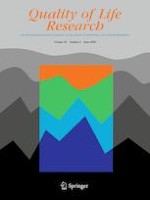14-01-2020
Assessing health-related quality of life in cancer survivors: factors impacting on EORTC QLU-C10D-derived utility values
Gepubliceerd in: Quality of Life Research | Uitgave 6/2020
Log in om toegang te krijgenAbstract
Purpose
To investigate the factors influencing EORTC QLQ-C30-derived EORTC QLU-C10D utility values across five cancer types (non-Hodgkin lymphoma, multiple myeloma, colorectal, thyroid, and prostate cancer) and a general population sample.
Methods
Data from the Dutch population-based patient-reported outcomes following initial treatment and long-term evaluation of survivorship (PROFILES) registry collected between 2009 and 2012 were used. EORTC QLQ-C30 data were used to estimate utility values by applying the EORTC QLU-C10D instrument using Australian utility weights. Regression analyses were conducted, within and across cancer type, to examine the factors influencing utility values, including patient- and cancer-specific factors, as well as the EORTC QLQ-C30 scale/item scores.
Results
The mean utility value for the total cancer sample was 0.791 (SD 0.201), significantly lower than that from the general population (0.865, SD 0.165). Multiple myeloma patients had the lowest utility value at 0.663 (SD 0.244). Physical functioning, pain and nausea and vomiting were the health-related quality of life (HRQoL) domains with the greatest impact on utility values; cognitive functioning and dyspnea had the lowest impact. Of the demographic and clinical factors, unemployment for reasons other than retirement, age older than 75 years, number of comorbidities, and experience of symptoms all had a statistically significant negative impact on utility values.
Conclusions
This study is one of the first to apply the EORTC QLU-C10D to a heterogeneous group of cancer patients. Results can be used to more efficiently target care towards factors influencing HRQoL. Furthermore, it enhances our understanding of how the EORTC QLU-C10D performs across cancer types, supporting its use in cost–utility analyses.
